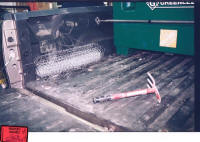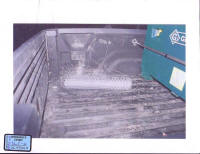Exhibits
People's 116A, the chicken wire in the bed of the truck. Defendants 6X 1-2 show the same. Click to enlarge.
Test Results
Sarah Yoshida described her examination of both the pliers and the chicken wire. The yellow-handled pliers were not used to cut the chicken wire.
HARRIS: Now, based on what you saw of these particular pliers, Modesto PD number 144, and depicted in 214 B, could you tell if those had been used to cut the chicken wire
YOSHIDA: No.
HARRIS: "No" you couldn't tell or "no," they weren't used to cut the chicken wire
YOSHIDA: They were not used to cut the chicken wire.
HARRIS: And how is it that you were able to determine that
YOSHIDA: Well, what I did, going back, I examined the cut ends of the chicken wire. I did not use these specific tools because I knew by looking at them that there had been change over time. There was no recent, as in no rust has been cleared from cutting anything,
HARRIS: Let me stop you there. What do you mean by that, that rust had not been cleared by cutting anything
YOSHIDA: Well, when you, when you have something that's rusted and you use it to cut something, some of that rust is going to get brushed away, so you're going to see clear areas on the cutting edge where the rust has been removed. So you're going to see metal, and what you can see in the photographs is all I could really see was rust all along the cutting surfaces. This is going to create change, any type of tool mark that I, test mark that I would have made. So what I did was I took tools that were similar to this in the laboratory and used them to cut some of the chicken wire. And the cuts that I made were nothing at all like what I observed at the end of the chicken wire. So the chicken wire was not even cut with a similar tool like these types of cutting surfaces.
HARRIS: Just to go back through this, break this down so that we all understand. When you use a tool to cut a piece of wire, like this chicken wire, does it leave some type of distinct impression or mark that you can look at?
JUDGE: Talking about on the tool or on the chicken wire?
HARRIS: Have her, On either one or both
YOSHIDA: It can be on either one or both. Sometimes it's a mark you can use, and sometimes it's a mark that you can't use.
HARRIS: Now, when we're talking about cutting the chicken wire, you use a tool to cut it, does it create a straight cut? Or angled cut? Or what was it that you found on the chicken wire
YOSHIDA: What I found on the chicken wire wasn't really a straight cut or a sharp angle cut. It appeared to be more of a shearing. It was more sheared than actual cut. It looked like it had been maybe, whatever tool was used on it maybe stretched and pulled a little bit before the ends actually broke apart from one another. But with the wire cutters, or with, excuse me, the needle-nosed pliers and its wire-cutting surfaces, the tool edges were very angular, and those are the types of marks I saw. So on the chicken wire I saw tented type cut, or cut ends on my test marks. But that's not what I saw on the chicken wire.
HARRIS: So in terms of the physical mechanics of how that worked, you were able to tell from looking at the test tool and the chicken wire that this type of tool was not the one that had cut the chicken wire
YOSHIDA: Correct.
HARRIS: So regardless of whether these were recently rusted or had been rusted over two months, this tool did not make that cut
YOSHIDA: Correct.
Yoshida confirmed that a pair of red-handled wire cutters, also collected as evidence, had not been used to cut the chicken wire.
HARRIS: Now, were you also given another pair of red handled pliers
YOSHIDA: I believe they were wire cutters.
HARRIS: Wire cutters. And your particular number for that was, 151 A is what it was identified as
YOSHIDA: Yes.
HARRIS: And so, again so that we're just talking about making sure it's the same, that we're all on the same page, these wire cutters, do they have the same type of mechanical properties of this particular pliers? Or is it something different
YOSHIDA: Similar. Looked like the pliers.
HARRIS: So it's, it's a pair of wire cutters which has mechanical function that comes together in some teeth or blade portions that squeezes the wire together
YOSHIDA: Correct.
HARRIS: Did you get that same kind of tent as you were describing it when you practiced a test cut with the wire cutters
YOSHIDA: Yes.
HARRIS: So with the two items that were provided by the Modesto Police Department, the red handled wire cutters and the 144, these yellow-handled pliers, those are not the items that cut that chicken wire
YOSHIDA: Correct.
Conclusion
Once again, even though the State's theories are proven wrong, the lead detective will not admit it:
GERAGOS: Okay. Now, specifically the fact of the matter is, as you sit here, though, today, there is absolutely no evidence whatsoever if you fast forward to the recovery of Laci Peterson's body the chicken wire had anything to do with anything, correct?
GROGAN: Well, there's no evidence that chicken wire was attached to her body that we had recovered, that's correct.


